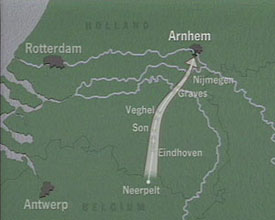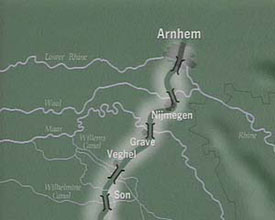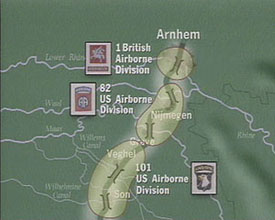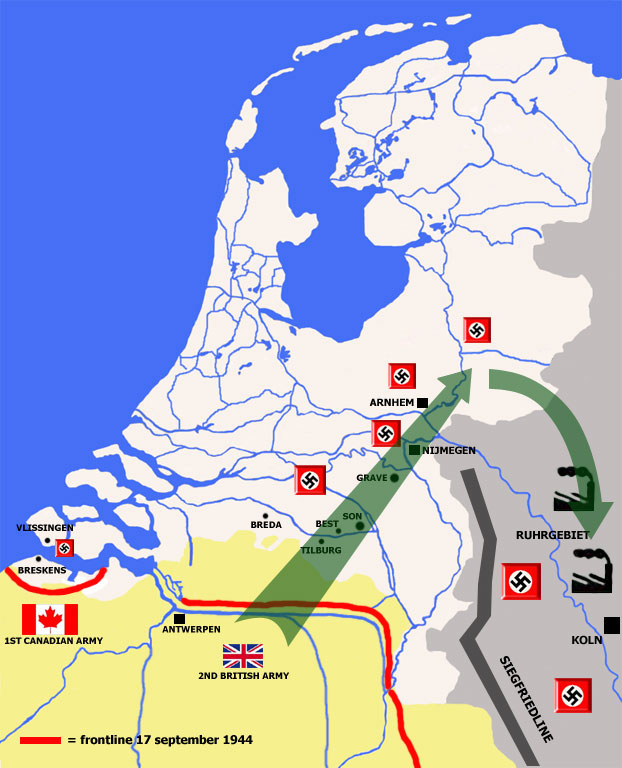THE ATTACK PLAN: OPERATION MARKET GARDEN |
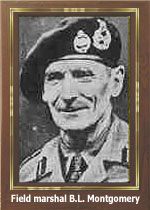 By the beginning of September 1944, British, American and
other allied forces advancing rapidly from the Seine, had liberated most of France and
Belgium. After a short pause for re-organization, they were ready for further advances by
the middle of that month. Field-Marshal Montgomery felt that a
pencil-like thrust northward through Holland and then eastward into Germany, outflanking
the Siegfried Line and striking along the main route to Berlin across the plains of
Northern Germany, offered excellent prospects of bringing the war to an early end. By the beginning of September 1944, British, American and
other allied forces advancing rapidly from the Seine, had liberated most of France and
Belgium. After a short pause for re-organization, they were ready for further advances by
the middle of that month. Field-Marshal Montgomery felt that a
pencil-like thrust northward through Holland and then eastward into Germany, outflanking
the Siegfried Line and striking along the main route to Berlin across the plains of
Northern Germany, offered excellent prospects of bringing the war to an early end.The first step was to secure the crossings of the rivers Rhine, Waal and Maas in the general area Grave, Nijmegen and Arnhem. To achieve this he decided to lay a carpet of airborne troops, who would seize and hold the crossings over these rivers and facilitate the advance of the Second British Army northwards. To the British First Airborne Division was allotted the task of capturing intact the bridges at Arnhem and establishing a bridgehead round them so that formations of the British Second Army could pass through without delay on their advance northwards. The crossings at Nijmegen and Grave were to be taken by the 82nd American Airborne Division and those between Grave and Eindhoven by the 101st Airborne Division. |
VISUALISATION |
|
AXIS DEFENSE IN SEPTEMBER 1944 |
 September
4 1944, Hitler made Field-marshal Walther Model commander of B Army. When
Model had arrived he was facing huge difficulties. His army was split in two by the
Allies. One half, the 15 th Army was located south of The Westerschelde making an effort
escaping to Brabant. The other half, the 17th Army, was set-back to Maastricht and Aken by
the American Army. Between the two Army's lies a gap of 120 km. September
4 1944, Hitler made Field-marshal Walther Model commander of B Army. When
Model had arrived he was facing huge difficulties. His army was split in two by the
Allies. One half, the 15 th Army was located south of The Westerschelde making an effort
escaping to Brabant. The other half, the 17th Army, was set-back to Maastricht and Aken by
the American Army. Between the two Army's lies a gap of 120 km.Through this gap German soldiers and collaborators were escaping Northward in panic. Model was a master in defensive actions. He had to save the Western front. By acting fast the German flee was stopped. The 15th army succeeded in escaping to Brabant, closing the gap. Now a strong defensive line was established again. The 9th SS Hohenstaufen and the 10th SS Frundsberg armored-divisions were called back by Model from Luik, to take a rest in the quiet surroundings of Arnhem and catch up from their heavy exertion in the Normandy. The tanks were hidden in the wooded terrain, repairs were made and the divisions supplied. Commanding-officers were stationed in several places around Arnhem. Model himself in Oosterbeek the village where the heaviest fighting would be taking place later. In Wolfheze (the landing-zone) an SS training battalion was formed. Now, a large concentration of various units were stationed in the Arnhem area, including Luftwaffe troops from the nearby Deelen Airfield. |
THE FRONTLINE ON SEPTEMBER 17th 1944 |
Pre WWII
studies from the Dutch Army learned that this would almost be impossible to accomplish, as
vehicles moving on this long small road would be easy targets for air and ground attacks. Just the reason why the German invasion in Holland in 1940 was planned differently, and also the reason why French help was not able to reach their targets in Holland on time to assist the Dutch Forces, as secretly agreed by both countries in case of an attack from Germany on France. |




















